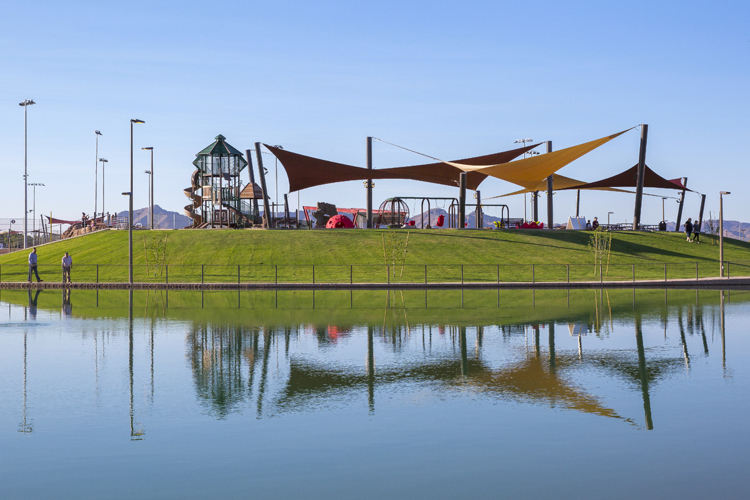Parks have long been a symbol of many things: fun, youth, memories and friendships, but Valley park developers are helping them become more of a fixture in the community through additional features like splash pads, courts, fields and even large lakes for fishing.
Arizona is experiencing a rising trend for recreational parks to include a wide variety of features with the goal of delivering a facility that will adequately serve as many people as possible. Parks throughout the state, and especially in the East Valley, are doing this through incorporating multi-functional use into the way new parks are designed.
Queen Creek’s Mansel Carter Oasis Park, in particular, strives to focus on inclusivity for all its local residents that visit the park. Adam Robinson, recreation manager for the Town of Queen Creek, said that through its design, the Mansel Carter Oasis Park has followed the industry trend to navigate away from the idea that most people have in mind for a “classic” park aimed only toward families with small children and youth athletes, instead choosing to incorporate a “new wave of improvements” that provide spaces for the whole family to get together.
One of the top ways that the Mansel Carter Oasis Park has brought value and created a welcoming environment in the community, Robinson said, is by encouraging people to get to know one another and develop relationships with their neighbors and local peers. Robinson said that since the park’s opening in 2018 he has witnessed a rise in interaction between members of the community, from children having birthday parties at the park to church groups holding meetings there and more.
“Parks build community,” Robinson said. “(If you bring) grandpa to go fishing, he might meet friends and buddies, and now there’s also a social aspect to it. Kids that play with teams, they become best friends, the families become friends and they grow together.”
Through the park’s various amenities, Robinson said he hopes residents of the Queen Creek community also use the outdoor recreational facilities to develop habits to become healthier, both mentally and physically. Some of Mansel Carter Oasis Park’s specific features include a 5-acre fishing lake, wheel-friendly skate plaza, shipwreck-themed splash pad and more. Each element of the park is designed to serve people of all ages and abilities.
Fritz Behrhorst, vice president of pre-construction at Haydon Building Corporation, which constructed Mansel Carter Oasis Park, said he and others at Haydon Building Corp. try to “include something for everybody,” so that entire families can spend a day at the park together and create lasting memories. “While one brother’s out playing soccer or something at one of the youth fields, the other brothers and sisters who are maybe not on a league yet are over at the playground playing, and mom and dad are watching both games, so it’s kind of a multi-use experience for the whole family,” Behrhorst said.
The design elements of the Mansel Carter Oasis Park and other regional parks like it “spells a trend towards very interactive play features. Most of the larger and more sophisticated parks that we’re doing have elements like that,” Behrhorst said, “so that people have both passive play areas like fields, places where you can have games and stuff like that, and then more structured play areas like splash pads and play equipment where there’s something you can climb on, something that’s interactive.”

Behrhorst said that the large, accessible play structures such as the splash pad are usually the thing that first draws people into the park, but once families arrive with their children, they stay for the other features like the walking trails and ball fields.
To build a large regional park such as Mansel Carter, Behrhorst said almost “every type of construction that there is in the industry” is involved, including infrastructure, earth work projects, irrigation and plumbing. The complexity of building the park and the sheer number of people involved in its running smoothly make it all the more rewarding to the builders when the park finally opens and the community excitedly interacts with it.
Behrhorst said that when it comes to deciding the specifics of designing a regional park and choosing what amenities to include, the individual needs of the local community are the most important factor, and that public opinion is an integral step to begin the process. One of the earliest stages of park design is the public input period, in which the design team interacts directly with residents to determine the demand for specific park features.
“There’s pretty elaborate and neat studies that get done,” Behrhorst said. “There’s a whole science to designing a community park or a regional park and how many resources are needed, how many basketball courts or how many tennis courts, (whether) they need fishing, how much play and how many multi-use fields are in the area.” The 48-acre park includes ten varying lighted fields and ball courts, ADA accessible playground areas, a 13-feet deep lake full of imported trout for fishing, and more.
The lake benefits the town of Queen Creek by using the town’s recycled water both to fill the lake as well as to irrigate the park’s grass. The lake gets its water by pumping recovered water from homes that is non-potable, or unsafe for drinking but suitable for other uses. The water from the lake is also used to irrigate the grass at night while the park is closed, so that the turf is dry and ready to use by the time park guests arrive to play in the morning.
Robinson said one of the most important aspects of the lake is that it brings fishing to the park, which is a type of recreation that can be enjoyed by both children and adults, regardless of physical ability.
In addition to the lake, Robinson said, the park’s playground structure surfacing was designed to be all-inclusive by covering the ground with padded rubber instead of the more common sand or wood chips, to ensure it maintains the “inclusive nature of making fun play for everybody, not just targeted groups.” The rubber surfacing was installed using a $130,000 donation from Banner Ironwood Medical Center, making Mansel Carter Oasis Park an IBCCES Certified Autism Center.
Another way that Mansel Carter Oasis Park strives to include a vast array of recreation options is with the design of its wheel-friendly skate plaza. “What we did with the skate park is something that’s kind of trending nationwide, and that’s to make it a wheel-friendly park,” Robinson said. “It’s not just skateboards or scooters, it’s also built for bicycles, or if you had rollerblades, even roller skates.”
All-inclusive regional parks are “absolutely vital” to communities across the state, Behrhorst said, as they provide an incentive for new residents who are considering moving into the area. Parks thus add economic value to nearby homes, and could make the neighborhood a more attractive place to live for potential homeowners.
Behrhorst said the Mansel Carter Oasis Park has had so much popularity and success that it is sometimes difficult to find a parking spot due to the large demand of community members who enjoy all of the park’s features. “We have 345 days of good weather here, and even in the summer people are out there in 110 degree heat playing on the splash pad,” Behrhorst said.
As for the future of designing large regional parks across the Valley, Behrhorst said there is a big push overall for inclusivity within a park’s features that has become more common for all types of parks as they aim to draw in as many visitors as possible.
“The more and better parks you have, the more the community members and residents get outside and participate,” Robinson said. “Just getting outside is step one, and you’re already on the road to a healthier life.”
As society continues to evolve to focus more on inclusivity, so do the state’s recreational parks, offering the kids of today more wide-ranging options to build friendships and make memories that will last a lifetime.




